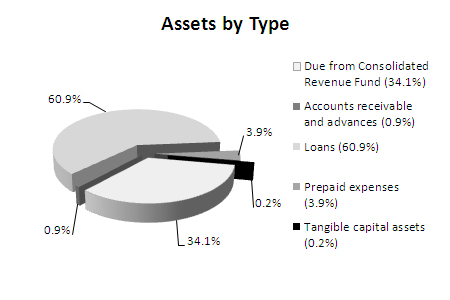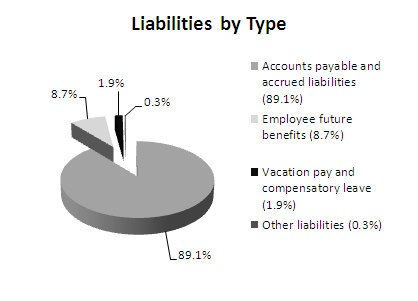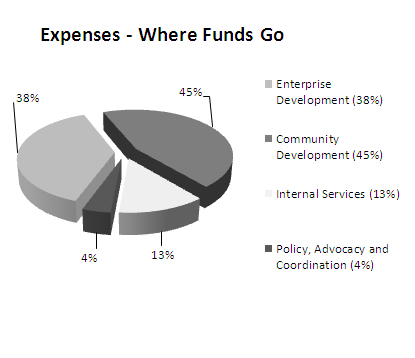Common menu bar links
Breadcrumb Trail
ARCHIVED - Atlantic Canada Opportunities Agency - Report
 This page has been archived.
This page has been archived.
Archived Content
Information identified as archived on the Web is for reference, research or recordkeeping purposes. It has not been altered or updated after the date of archiving. Web pages that are archived on the Web are not subject to the Government of Canada Web Standards. As per the Communications Policy of the Government of Canada, you can request alternate formats on the "Contact Us" page.
Section III: Supplementary Information
Financial Highlights
The financial highlights presented herein are intended to serve as a general overview of ACOA’s financial position and operations.
| % Change | 2010-11 | 2009-10 | |
|---|---|---|---|
| Total assets | 10% | 362,709 | 328,763 |
| Total liabilities | 21% | 140,898 | 116,477 |
| Equity of Canada | 4% | 221,811 | 212,286 |
| Total Liabilities and Equity | 10% | 362,709 | 328,763 |
| % Change | 2010-11 | 2009-10 | |
|---|---|---|---|
| Total expenses | 7% | 358,590 | 384,688 |
| Total revenues | 1% | 9,098 | 9,231 |
| Net cost of operations | 7% | 349,492 | 375,457 |
Financial Highlights - Graphs

Total assets were $362.7 million at the end of 2010-11, an increase of $33.9 million (10%) over the previous year’s total of $328.8 million. The majority of the increase is the account Due from Consolidated Revenue Fund. The primary reason for this increase is the accrued liabilities of the Building Canada Fund – Communities Component.

Total liabilities were $140.9 million at the end of 2010-11, an increase of $24.4 million (21%) over the previous year’s total of $116.5 million. The increase relates to accrued liabilities for programs (i.e. the Building Canada Fund – Communities Component) as explained above.

Total expenses were $358.6 million in 2010-11. Of these funds, $161.3 million (45%) was spent in the Community Development program activity, while $137.8 million (38%) contributed to the Enterprise Development program activity. The total expenditures have decreased by $26.1 million (7%), primarily resulting from a decrease in the total of non-repayable and provisionally repayable contributions.
Financial Statements
The Agency’s financial statements can be found on ACOA’s website.
List of Supplementary Information Tables
All electronic supplementary information tables found in the 2010–11 Departmental Performance Report can be found on the Treasury Board of Canada Secretariat’s website.25
- Details of Transfer Payment Programs
- Evaluations and Internal Audits
- Green Procurement
- Horizontal Initiatives
- Responses to Parliamentary Committees and External Audits
- Sources of Non-respendable Revenue
- User Fees
Section IV: Other Items of Interest
Organizational Contact Information
ACOA Head Office
Blue Cross Centre, 3rd Floor
644 Main Street
P.O. Box 6051
Moncton, New Brunswick E1C 9J8
(Courier address: E1C 1E2)
General inquiries: 506-851-2271
Toll free (Canada and the United States): 1-800-561-7862
Facsimile: 506-851-7403
Secure Facsimile: 506-857-1301
Access to Information/Privacy: 506-851-6202
TTY:26 1-877-456-6500
http://www.acoa-apeca.gc.ca/English/Pages/Home.aspx
Additional Information
The following information is available on ACOA’s website.
- Atlantic Canada’s 2010-11 Economic Overview and Provincial Economic Profiles
- BDP Repayable Contributions Portfolio
- Information on program sub-activities of ACOA’s Program Activity Architecture
- Innovation
- Entrepreneurship and Business Skills Development
- Trade
- Investment
- Financing Continuum
- Community Mobilization
- Community-based Business Development
- Community Investment
- Infrastructure Programming
- Policy
- Advocacy
- Coordination
[Footnotes]
[1] “Type” definitions:
- New (newly committed to for fiscal year 2010-11)
- Previously committed to (committed to one or two fiscal years earlier, i.e. 2008-09 or 2009-10)
- Ongoing (committed to at least three fiscal years earlier, i.e. 2007-08 or earlier)
[2] Cumulative five-year target (2008-09 to 2012-13).
[3] Beginning with the 2009-10 Estimates cycle, resources for the Internal Services program activity are displayed separately from the other program activities (i.e. they are not distributed among the other program activities as was done in previous Main Estimates). This has affected the comparability of spending and full-time equivalent (FTE) information by program activity across fiscal years.
[4] CAF actual spending includes $2.4 million from ACOA’s regular authorities.
[5] See Public Accounts of Canada for 2011.
[6] Enrico Giovannini, Understanding Economic Statistics - An OECD Perspective (Paris, France: Organisation for Economic Co-operation and Development, 2008).
[7] Comparable firms are similar to ACOA-assisted firms (age, size, sector and geographic region) but have not received a direct monetary contribution from the Agency. The analysis is used to determine the five-year survival rate of start-ups over a ten-year period (i.e. 1998 through 2008). Survival rates are calculated annually by tracking firm births (businesses newly identified in the Longitudinal Employment Analysis Program of Statistics Canada) and deaths (businesses no longer identified). As a result of feedback received on the 2011-12 Report on Plans and Priorities, in future planning cycles the Agency will clarify its target relative to the survival rate of comparable firms.
[8] Business Special Surveys and Technology Statistics Division, Statistics Canada (March 2011).
[9] Bloom et al., Management Practice and Productivity: Why they matter (London, United Kingdom: McKinsey & Co. and the Centre for Economic Performance, 2007).
[10] Atlantic Canada Opportunities Agency, Evaluation of the Atlantic Canada Opportunities Agency’s Entrepreneurship and Business Skills Development Program Sub-activity - Final Report (Moncton, New Brunswick: ACOA, September 8, 2010).
[11] Canada-Atlantic Provinces Agreement on International Business Development (April 1, 2005).
[12] Atlantic Canada Opportunities Agency, Impact Evaluation of the Atlantic Canada Opportunities Agency Innovation Program Sub-activity - Final Report (Moncton, New Brunswick: ACOA, January 19, 2010).
[13] Atlantic Canada Opportunities Agency, Evaluation of the Atlantic Canada Opportunities Agency’s Entrepreneurship and Business Skills Development Program Sub-activity - Final Report (Moncton, New Brunswick: ACOA, September 8, 2010).
[14] Atlantic Canada Opportunities Agency, Evaluation of the Atlantic Canada Opportunities Agency Trade and Investment Program Sub-activity - Final Report (Moncton, New Brunswick: ACOA, September 8, 2010).
[15] Atlantic Canada Opportunities Agency, Evaluation of the Atlantic Canada Opportunities Agency Financing Continuum Program Sub-activity - Final Report (Moncton, New Brunswick: ACOA, September 8, 2010).
[16] Martha Reynolds Marketing, The Dawn of Canada’s Newest Wine Region: Nova Scotia (January 2007), pp. 24-25.
[17] Atlantic Canada Opportunities Agency, Evaluation of the Community Futures Program in Atlantic Canada - Final Report (Moncton, New Brunswick: ACOA, June 9, 2009).
[18] Atlantic Canada Opportunities Agency, Audit of the Community Futures Program - Final Report (Moncton, New Brunswick: Internal Audit Directorate, December 2009).
[19] Atlantic Canada Opportunities Agency, Evaluation of the Atlantic Canada Opportunities Agency’s Atlantic Policy Research Initiative – Final Report (Moncton, New Brunswick, ACOA, March 17, 2010).
[20] Two-year target (2009-10 through 2010-11).
[21] Canada Business was unable to obtain approval to conduct a public-opinion survey to measure the level of client satisfaction; thus, data for this performance indicator is not available. A fact-based survey was conducted in 2010-11, but consists of measures different from a public-opinion survey (see footnote 22).
[22] Industry Canada, Canada Business Network 2010 Client Survey, Phoenix Strategic Perspectives Inc. (March 2011). The survey was administered using two different formats: interviewer-administered (by telephone) and self-administered (on paper). In total, 996 surveys were completed: 400 by telephone with Canada Business Network call centre clients and 596 on paper with clients who obtained service at one of the business service centres. The results for these survey formats can be considered accurate to within ± 4.9%, 19 times out of 20 (phone) and ± 4.0%, 19 times out of 20 (paper). The fieldwork was conducted over a period of two months, from January to March 2011.
[23] Two-year target (2009-10 through 2010-11).
[24] Two-year target (2009-10 through 2010-11).
[25] See 2010-11 Part III – Departmental Performance Reports (DPR): Supplementary Information (Tables).
[26] A TeleTYpe or TeleTYpewriter (TTY) is a special device that lets people who are hearing- or speech-impaired to use a telephone to communicate by allowing them to type and read messages instead of talking and listening. A TTY is required at both ends of a conversation in order to communicate.
